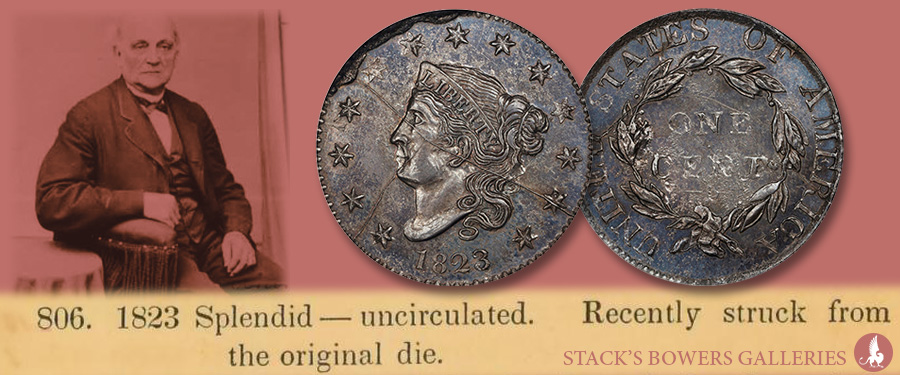
Private restrikes of three large cent dates, 1804, 1810, and 1823, were produced in the mid-to-late 19th century, a dynamic time in U.S. coin collecting. Though the circumstances surrounding their production remain murky, these restrikes have passed through the hands of many prominent coin collectors and have been studied by some of the most accomplished researchers in U.S. numismatics. Stack’s Bowers Galleries will offer a notable 1823 large cent private restrike in silver as lot 5012 in Rarities Night of our August 2023 Global Showcase Auction.
It is thought that the first of these restrikes were produced starting in the late 1850s or early 1860s through possibly as late as the turn of century; a terminal bookend is hard to establish as the dies used to produce the 1823 restrikes survive today. The start of this period was a seminal moment in American numismatics as the hobby caught on and private and U.S. Mint-produced restrikes and other oddities appeared in the burgeoning U.S. marketplace. Auction catalogs and numismatic publications of the era offer an incomplete account of the large cent restrikes and their origins. The first auction catalog appearances and media reports date to the 1860s.
The dies used to produce these restrikes were likely purchased as scrap from the Mint in the early 19th century. Joseph Mickley is often pointed to as the source for the 1804 dies. Mickley was a Philadelphia numismatist known for, among other things, helping to establish the Numismatic and Antiquarian Society of Philadelphia and authoring Dates of United States Coins and their Degrees of Rarity, one of the first collector reference books on U.S. coins. These dies, however, were not among the hubs and dies sold after Mickley’s death in 1878.
The obverse die used to produce the 1804 restrikes was actually dated 1803 (cataloged as Sheldon-261); the last date digit was modified. The reverse die was used for cents dated 1820 (Newcomb-12) which sported the Matron Head design on their obverses, the successor to the Draped Bust motif. The 1804 restrikes were produced in copper and white metal. They were first reported in 1869 in Mason’s Coin & Stamp Collector’s Magazine, which prompted numismatic researcher Mark Borckardt to place its production date as 1868 in a paper given at the November 1996 Coinage of the Americas Conference. This paper was the main source for this blog and is highly recommended reading.
The origins of the dies used to strike the 1823-dated restrikes are less clear. Some catalogers and writers of the period connect Mickley to these dies too. The dies changed hands a number of times and multiple emissions were produced, with experts estimating production dates as late as 1879. The 1823 restrikes were produced in two metals, copper and silver, and the obverse die cracked after the initial emission; Edward Cogan claimed that he struck 49 examples from the dies on behalf of the dies’ owner. Cogan then sold the dies to Montroville Dickeson who in turn sold them to John W. Haseltine. Both Dickeson and Haseltine are thought to have been involved in the production of these restrikes in later die states (likely produced in the 1870s), which sport a tripartite die crack across Liberty’s face. The reverse die was used to produce cents in 1813.
The 1823-dated restrikes were first reported by W. Elliot Woodward in his November 1862 catalog of the Finotti Collection, suggesting a production date in the early 1860s.
A handful of tin restrikes dated 1810 are known, with that obverse die paired with the 1820 reverse die used for the 1804 restrikes.





